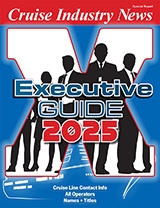Royal Caribbean Cruises (RCC) has reported net income of $52.5 million, or $0.27 per share, on revenues of $726.9 million for the first quarter ended March 31, 2001, compared to net income of $105.5 million, or $0.55 per share, on revenues of $707.8 million for the first quarter of 2000.
RCC attributed the increase in revenues to increased capacity, which was offset by a decline in yields. RCC said that the first quarter was down year over-year primarily as a result of the impact of the Millennium Cruises, which boosted last year’s first quarter. But RCC also said that bookings started to soften by mid-February and that pricing was lower than last year.
Richard Glasier, RCC CFO, said in a conference call that bookings were at the same level as last year but at lower prices and that he expected the yield to go down two percent for the year.
Glasier said that he expected the year to be impacted by the slowing economy as well as by new itinerary programs, the start up of Royal Celebrity Tours, and higher fuel costs.
Glasier said the company has been introducing new itineraries, some of which have been successful while others have not. Hence, one program has been cancelled while others are being modified. The bottom line is that it seems to be taking RCC longer to establish the new programs than it had anticipated. “We believe that when the new programs are established, they will have positive year-over-year results,” Glasier said.
According to RCC, the two brands, Royal Caribbean International (RCI) and Celebrity Cruises, will have a 30 percent increase in capacity in the second quarter year-over year, mostly in Alaska and Europe, where Glasier described the pricing as aggressive, especially in the shoulder seasons. Europe has also been impacted by negative publicity, he explained.
RCC expects a six to seven percent drop in yield in the second quarter, a smaller drop in the third quarter, and recovery in the fourth quarter, although Glasier admitted that the company has “limited visibility” into the fourth quarter.
Combined for the nine-month period, Glasier said that RCC expects a two to three percent decline in yield. The first quarter saw an 11 percent drop, which would put full-year 2001 yields down four to five percent.
RCI President Jack Williams commented that some of the new markets that the brand has ventured into need more development time; some need modification; and some new itineraries have not worked and need to be eliminated, he said.
In the Royal Journeys program, RCI will eliminate calls in Africa and some of the longer cruises, while offering more sailings in Australia.
Williams also said that he was a little disappointed with the results in South America and that the company will make some adjustments for next year.
He also noted that while RCC has very efficient yield-management forecasting, it has not been as effective in new markets as in the established markets.
Celebrity Cruises has also been impacted by the Millennium being out of service twice for repairs and the delayed delivery of the Infinity. Glasier said he was not confident that the engine manufacturer will reimburse the cruise line for loss of revenue for the recent engine repair.
Some negative feedback from the initial sailings of Radiance of the Seas were attributed to a new onboard hotel management concept by Williams (see Cruise Industry News, March 30, 2001).
He said there were some teething issues caused by too many inexperienced employees, which had now been overcome.
Williams also said that RCI expected to carry 1.2 million first-time cruisers this year and twice as many European passengers this year as last year.
Cost cutting remains in the company’s focus and Glasier said that while RCC was always looking to trim operating costs, the company would also reduce or defer administrative and marketing costs, but will not sacrifice its long-term strategy for the sake of two or three quarters. Despite investments in new itineraries and other programs being up this year, RCC continues to see significant long-term returns.
RCC Chairman Richard Fain described the present environment as a “negative phase” primarily attributed to the softening of the economy and said that he expects to see tremendous long-term benefits from the investments in new itineraries and in Alaska, starting in 2002.



